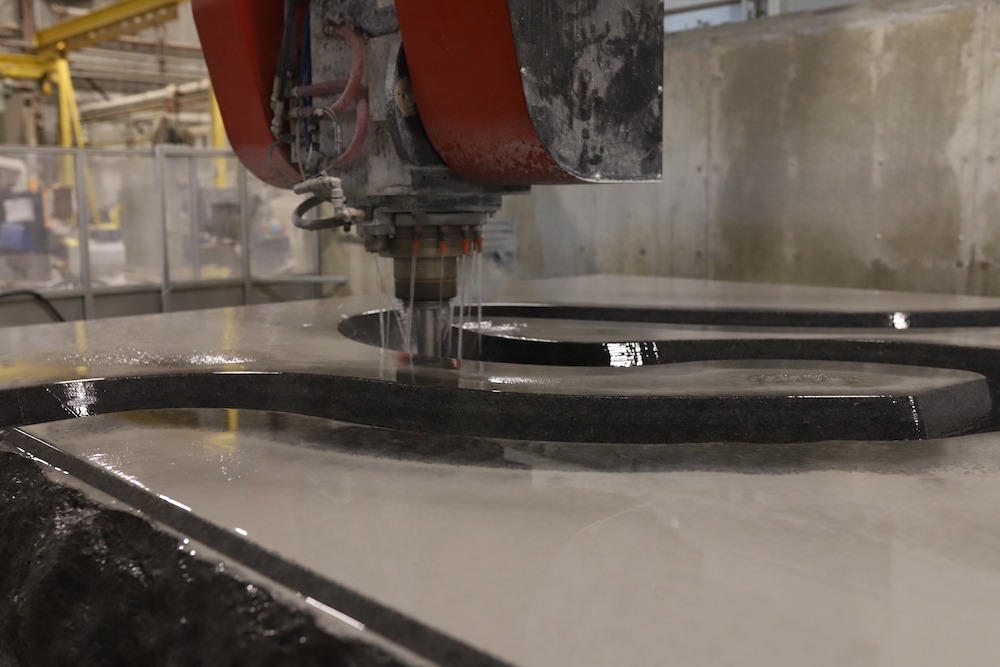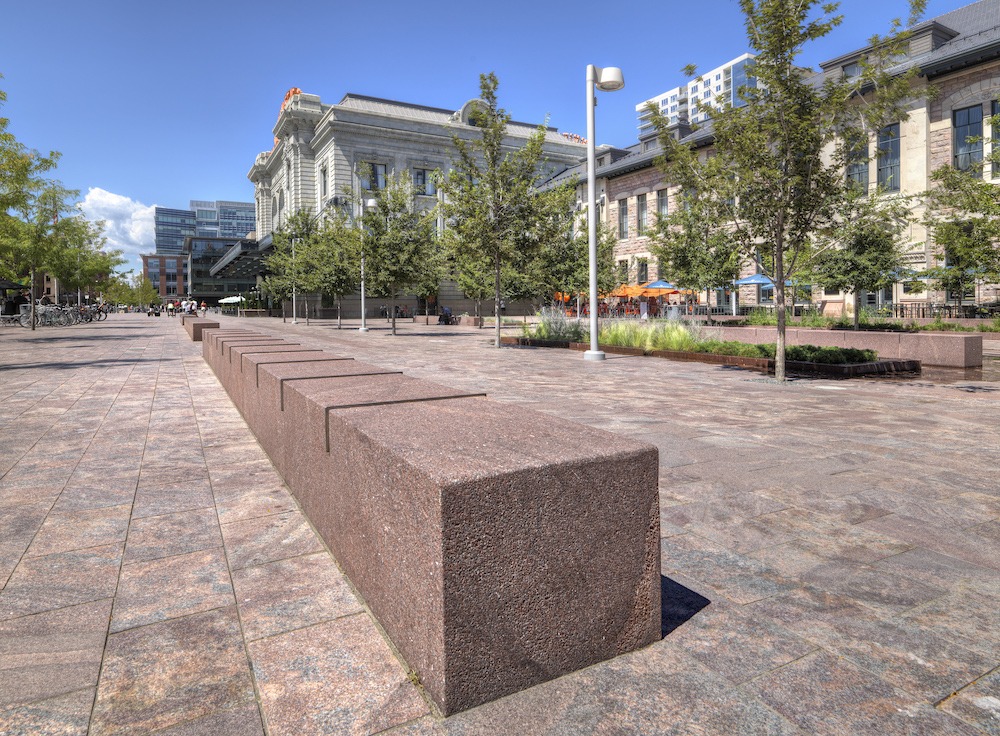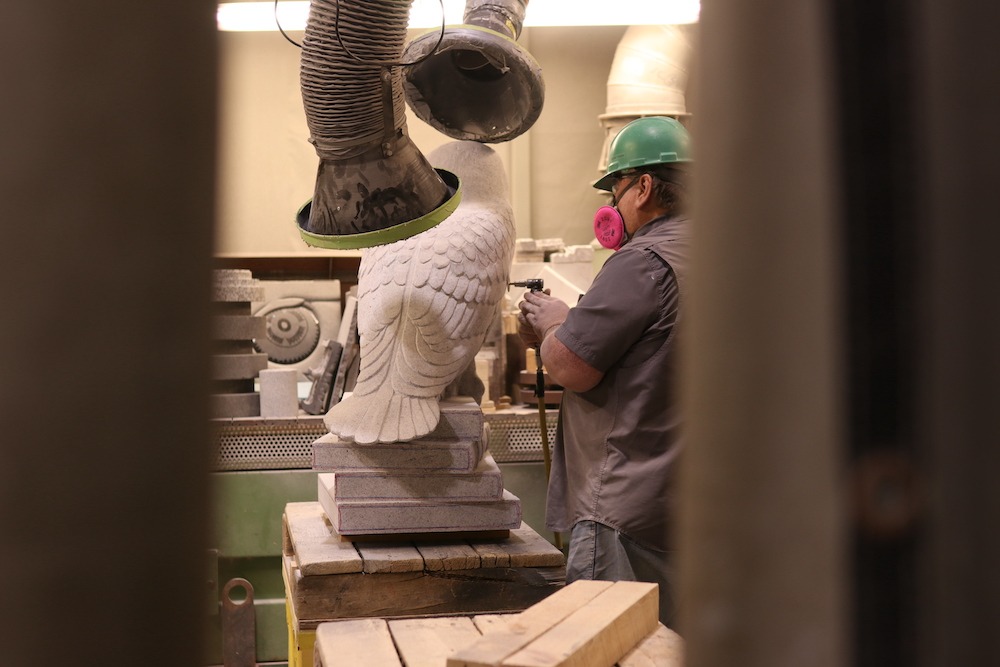Mastering Natural Stone Selection Despite Nearly Limitless Design Options
Words: Jason Kron, David Sparks, Steve Maylone
Words: Jason Kron
Photos courtesy of David Sparks Photography and Steve Maylone Photography
Natural stone has long been regarded as the premier choice for durability, ease of maintenance, and timeless design. Now armed with cutting-edge technologies, natural stone suppliers offer numerous capabilities for achieving the design intent. For example, AutoCAD and 3D modeling software allow computer-generated transfer of images and precision. Other technologies include CNC laser etching and stencil, and film technology.
With these capabilities, manufacturers can transfer nearly anything from hand sketches to photos onto the stone’s surface. Photographs and other images can be transferred to natural stone with realistic detailing using sandblasting and carving techniques. Lettering can be carved and enhanced with a color element, and the precise replication of ornate elements such as column caps can be created.
With nearly limitless design options, selecting the right natural stone for a project can seem daunting. However, by considering the material types, physical properties of each, and procurement sourcing, the selection process can be easily mastered.
Choosing the Right Material
When considering a stone for a project, consider the aesthetics of each stone. Look at its movement as well as its color, characteristics, and performance properties. Remember, when working with Mother Nature rather than a man-made product, great beauty abounds in the unique appearance provided by nature’s fingerprint.
Once a good understanding of the project and design is established, the material selection process involves discussing and reviewing factors starting with the types of natural stone.

- Granite. An igneous rock, granite, forms when magma cools slowly beneath the earth’s surface, forming large, easily visible crystals of quartz, feldspar, and mica. The granite quarried in North America comes mainly from the eastern and upper Midwest United States.
- Limestone. Limestone, commonly quarried across North America (particularly in the Midwest), is a sedimentary rock composed of calcium carbonate, plus calcium and/or magnesium. It is formed when layers of minerals, fine sediment, and the skeletons and shells of marine organisms. Limestone formed by mineral deposits from natural springs is known as travertine.
- Sandstone. Sandstone is a sedimentary rock formed when layers of eroded sediment are compressed and cemented with minerals. Composed mainly of sand-sized grains, or clasts, of quartz cemented with silica, calcium carbonate, or iron oxide, sandstone is quarried widely across North America, particularly in the West, Midwest, and Northeast.
- Marble. Formed when limestone is subjected to intense heat, pressure, and chemical solutions, marble is a metamorphic stone. When formed from very pure limestone, marble is white. But the presence of other minerals and clay, silt, and sand can give it richly varied coloration. Marble is found in the mountainous regions of most countries, but relatively few quarries exist in the United States.
- Slate. Slate is a metamorphic deposit that evolves from sedimentary rock consisting of clay or volcanic ash. The predominant mineral found in slate quartz and muscovite or illite, although it is typically composed of many minerals. The slate quarried in North America comes mainly from the eastern regions of North America.
Each natural stone possesses unique characteristics and can be used for a wide range of applications. The applications and the materials commonly used for each are:
- Cladding (interior and exterior)—Granite, limestone, sandstone, marble, and slate
- Landscaping—Granite, limestone, sandstone, marble, and slate
- Statuary—Granite, limestone, sandstone, and marble
- Flooring—Granite, limestone, marble, and slate
- Paving—Granite, limestone, sandstone, and slate
- Coping—Limestone, sandstone, and slate
- Molding—Granite, and marble
- Aggregate—Granite and limestone
- Countertops—Granite and marble
- Roofing—Slate
- Flagging—Sandstone
- Curbing, monuments, and Rip-Rap—Granite
- Lime and mulch—Limestone
The Natural Stone Council provides a detailed description of each material, including their products and applications, formation and sources, physical properties, durability recyclability and more at https://naturalstonecouncil.org/category/material-fact-sheet.
Getting Started
From owner and contractor to designer and architect, all involved in the process must be able to provide the stone supplier with a full understanding of the project and design concept. By asking the right questions, the stone supplier will have the full picture and will ensure the right stone can be chosen for the project. Questions to ask include:
- To ensure the stone will meet the design, function, and constructability goals for the project, what’s the intended application for the stone?
- Exterior
- Interior
- Commercial
- Memorial
- Building (building façade, building base)
- Landscape
- Paving
- Water features
- Slabs
- Blocks
- Are there additional opportunities for stone to be incorporated into the project design? Consider areas that could incorporate a matching or complementing stone to unify or connect areas of a project.
- What’s the intended installation system?
- Hand-set
- Precast
- Panelized
- Paving (mortar set, bituminous, pedestal, sand set)
Architectural drawings have become increasingly vague and less detailed in recent years. Installation details are often missed or loosely drawn, causing project teams to guess, manipulate or change the installation details completely. This can affect the overall design intent and leave owners and the entire project team with inferior product quality or increased costs. Asking these questions and working through the installation details early on sets everyone up for success.
- Will the stone choice meet the project’s needs?
- Monochromatic vs. variegated
- Fine vs. large grain
- Marking orientation
Designers can often overlook the natural characteristics of stone. A small sample may not provide the best representation of the stone that will be used for the project. Asking this question helps selection teams think about more than just color tones, but about the stone’s entire look and feel. Aesthetics are very important for most designers, so this question helps avoid surprises later in the process.
Other Considerations
Should the material be domestic or internationally sourced? Much will depend on the project’s schedule. Although the actual fabrication times for natural stone fabrication are similar for both domestic and international product sources, transportation from the factory to the project site can be significant with an international quarry or fabrication facility. With the current supply chain challenges impacting the industry, be sure to get a full understanding from your supplier – whether domestic or international – of the delivery timeline. You want to be sure the project specifies a product that is available and will meet the construction schedule.
In addition, other factors can influence domestic or international decisions. For example, if the project is a legacy project and the stone needs to match or complement existing buildings and nearby structures, a domestic stone will likely be the best source. Or, with veterans’ memorials and other iconic American projects, a domestic stone may be a high priority for stakeholders who wish to demonstrate patriotism.

The stone’s physical properties should also be evaluated based on its intended use. For example, will the stone be used for water features, a building’s base course, or paving applications? Will the paving be for pedestrian or vehicular use? And is there physical test data available to help support the material considerations?
Lastly, manufacturers and quarries understand the deposits and whether the quarry can provide the block size and amounts needed for the project. It’s important to keep in mind that certain quarries can yield larger block sizes than others. Large blocks would lend themselves to applications such as feature pieces, large façade panel sizes, solid columns, and artwork. Therefore, size limitations (as well as slabs vs. blocks) should be taken into account when choosing the material.
Natural stone materials, even among their varieties and colors, have very different characteristics. Speaking with a stone supplier can help in the decision process to ensure the right stone is selected for the application.
Choosing a Stone Supplier
When evaluating a stone supplier, be sure to consider these important questions:
- Does the supplier collaborate throughout the design process?
- Does the supplier own the quarry? Important quality control measures may be lost if the supplier outsources the stone.
- Does the supplier offer the latest in technology to enhance creative options?
- Does the manufacturer offer the capability to add handcraftsmanship when needed? A skilled craftsperson can give an image depth or bring a truly artistic touch to the project. Manufacturers that can offer both craftsmanship and technology will be best able to meet the project’s needs.
- Does the manufacturer offer quality control such as traceability? A numbering system from inception all the way to the job site allows manufacturers to locate exactly where the piece was obtained from, should a need for a replacement ever arise. Capable manufacturers should be able to trace each piece back to the quarry and the specific vein from which it came.

Navigating the stone selection process doesn’t have to be difficult when you’ve partnered with a qualified supplier. By collaborating and employing the latest in stone fabrication technology, design teams will find a source for creative inspiration to produce results that stand the test of time.